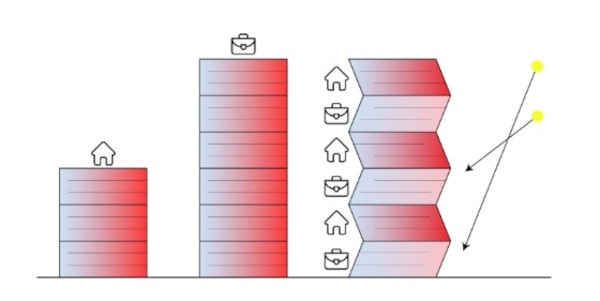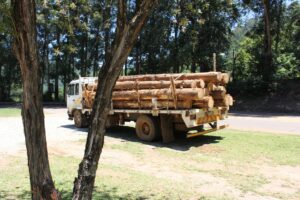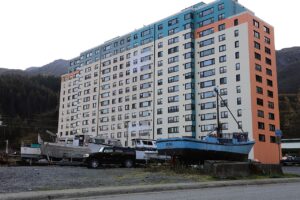
In the midst of the climate crisis announced by the IPCC, municipalities around the world and their residents are seeking to minimize their environmental impact. This includes designing sustainable, energy-efficient homes, a challenge that is far from trivial: to a large degree, it depends on the existing surroundings.
In the image above, a building in Toronto (Canada) aims to maximize thermal capture with large windows that allow light to enter and with dark shades on its facades. The latter help retain the heat of the sun.
Embodied energy in buildings
All materials, everything from wood to concrete, steel, and ceramics, need energy to be manufactured. This energy is usually called ’embodied energy,’ which is an unusable type: once a brick has been made, it isn’t possible to extract energy from it, so we had better use the brick as best we know how and for as long as it is safe.
For example, adobe has an embodied energy of 0.4 MJ/kg (megajoules per kilogram), concrete is at 1.3 MJ/kg, wood at 15 MJ/kg, plastics at 80 MJ/kg, and glass 350 MJ/kg. Building glass houses is not a good idea in terms of energy, nor in any other regard, for that matter.
Of course, embodied energy is a simplification with some variability, but along with embodied water, it is smart to reduce embodied CO2 or the use of embodied land as much as possible. It is estimated that building a house consumes 40% of the CO2 of its entire useful life, so paying attention to energy costs is key.
Sustainable housing is durable housing
In addition, it is a good idea to make the house last as long as possible, though some elements have to be renovated along the way, such as replacing the roof after 50 years or doing the same with the pipes. The more years the same building lasts, the more distributed its manufacturing footprint will be, and the more ethical the use of those materials will be.
Sustainable housing is durable housing, and this is why it is worth reusing buildings, not tearing them down after just one hundred years of service. For example, it is becoming increasingly common to transform abandoned shopping malls into residential buildings, harnessing their original materials.
Local materials for construction
It is also quite helpful to use nearby materials for building in this calculation, mainly due to the ecological impact of transporting heavy materials. Moving construction materials, which usually weigh quite a lot, has a significant associated footprint. The shorter the distance from the extraction point, the lower that impact will be.
Educational labor and conscious consumption also come into play. When we use resources that come from far away, we lose that connection with the environmental and social repercussions of our activity.
Is it possible to have a house without forced air conditioning?
The other 60% of the CO2 of a house is derived from its use, with a focus on air conditioning. This emits 30% of the total emissions associated with a house during its useful life (considering only what happens inside; later, we will see what happens outside). The boiler in winter or the air conditioner in summer, and even fans, are forced air conditioning systems: they need to consume energy to function and provide heat or cold for the house’s interior.
For example, a house in Spain (this data is from the IDAE) consumes about 5,300 kWh in air conditioning alone, which is doubled in a single-family home. However, there are ways to reduce this consumption considerably: by designing homes that make it possible to reduce energy expenditure on air conditioning and even do without appliances.
A few years ago, the architectural firm Bjarke Ingels Group proposed an idea that was not new, but that offered a new perspective: residential buildings with offices and shops under them, with facades positioned in an accordion. This shape lets the offices (heat generators) prevent heat loss in winter and have it in the summer; the houses also have almost free air conditioning in winter and a way to release heat during the night (to the offices). It’s no magic bullet, but it’s something to consider.

Passive air conditioning is the holy grail of urban planning, though we know that narrow streets, white facades, and a lot of vegetation significantly help reduce air conditioning in hot climates; in cold climates, thick walls and thermal mass help, as do dark buildings facing south. Part of bioclimatic engineering and architecture seeks to design spaces that self-regulate, sometimes copying nature with fascinating thermo-regulation solutions such as what you see in a termite mound.
How is the most sustainable and efficient housing possible?
There’s a joke in engineering that starts with “Given a perfectly spherical chicken…” The point is that what works on paper probably doesn’t make sense in reality. In fact, spherical housing is terribly efficient because it minimizes surface losses. Building it, let alone furnishing it, is another story.
Efficient housing has floors above and below that prevent energy losses and swaps out car rides for elevator rides. Normally, skyscrapers pose an obstacle to energy efficiency because the high volume of housing makes it difficult to let out heat. However, in Whittier, Alaska (image), the ”human warmth” of the houses offers protection from the freezing winter.
On ice, the most efficient dwelling is an igloo. In the desert, it is a cave isolated from the sun and protected by rock. But most of us live in areas that are neither of these extremes. And the environmental conditions are different. What is smart in Ecuador, such as setting up pergolas or brises-soleil, is a waste of energy in cold climates.
The most sustainable and efficient housing depends on the location where it is built, the materials that are nearby, the use it will have, and the number of people who will inhabit it.
Main image: Nadine Shaabana,







4 comments
Akshay Sharma
20 of March of 2024
Wow, what an incredible blog post! Thank you so much for sharing your insights and expertise on energy efficiency. Keep up the fantastic work, and I can't wait to read more from you in the future! At Inventum POwer we're passionate about providing the best energy efficiency services to help individuals and businesses reduce their carbon footprint while saving money. Website - https://inventumpower.com/energy-audit-services
Akshay Sharma
20 of March of 2024
Wow, what an incredible blog post! Thank you so much for sharing your insights and expertise on energy efficiency. Keep up the fantastic work, and I can't wait to read more from you in the future! At Inventum POwer we're passionate about providing the best energy efficiency services to help individuals and businesses reduce their carbon footprint while saving money. Website - https://inventumpower.com/energy-audit-services
Akshay Sharma
20 of March of 2024
Wow, what an incredible blog post! Thank you so much for sharing your insights and expertise on energy efficiency. Keep up the fantastic work, and I can't wait to read more from you in the future! At Inventum POwer we're passionate about providing the best energy efficiency services to help individuals and businesses reduce their carbon footprint while saving money. Website - https://inventumpower.com/energy-audit-services
Akshay Sharma
20 of March of 2024
Wow, what an incredible blog post! Thank you so much for sharing your insights and expertise on energy efficiency. Keep up the fantastic work, and I can't wait to read more from you in the future! At Inventum POwer we're passionate about providing the best energy efficiency services to help individuals and businesses reduce their carbon footprint while saving money. Website - https://inventumpower.com/energy-audit-services